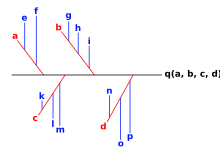Graphic organizer
Appearance
A graphic organizer, also known as a knowledge map, concept map, story map, cognitive organizer, advance organizer, or concept diagram. It is a pedagogical tool that uses visual symbols to express knowledge, concepts, thoughts, or ideas, and the relationships between them.[1] The main purpose of a graphic organizer is to provide a visual aid to facilitate learning and instruction.[1][dead link][2]
Types of forms
Graphic organizers take many forms:

- Relational organizers
- Storyboard
- Fishbone - Ishikawa diagram
- Cause and effect web
- Chart
- Category/classification organizers
- Sequence organizers
- Chain
- Ladder
- Cycle
- Compare contrast organizers
- Concept development organizers
- Story web
- Word web
- Circle chart
- Flow chart
- Options and control device organizers
Enhancing students' skills
A review study concluded that using graphic organizers improves student performance in the following areas:[3]
- Retention
- Students remember information better and can better recall it when it is represented and learned both visually and verbally.[3]
- Reading comprehension
- The use of graphic organizers helps improving the reading comprehension of students.[3]
- Student achievement
- Students with and without learning disabilities improve achievement across content areas and grade levels.[3]
- Thinking and learning skills; critical thinking
- When students develop and use a graphic organizer their higher order thinking and critical thinking skills are enhanced.[3]
See also
References
- ^ a b
"Instructional Strategies Online - Graphic Organizers {waves}". Olc.spsd.sk.ca. 1999-01-01. Archived from the original on 2013-03-10. Retrieved 2012-10-13.
{{cite web}}: Unknown parameter|deadurl=ignored (|url-status=suggested) (help) - ^ Compare: "50 Uses of Graphic Organizers and Rubric". University of Wisconsin Stout: School of Education. University of Wisconsin. Retrieved 2016-08-12.
- ^ a b c d e Graphic Organizers: A Review of Scientifically Based Research, The Institute for the Advancement of Research in Education at AEL [1]
External links
